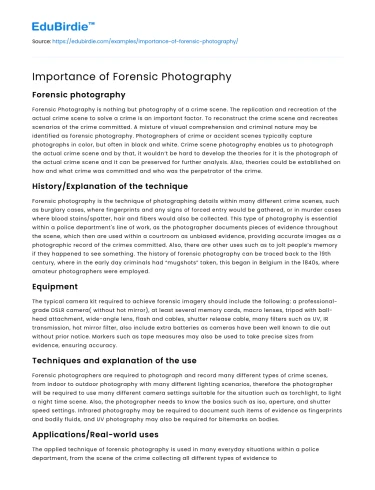Forensic photography
Forensic Photography is nothing but photography of a crime scene. The replication and recreation of the actual crime scene to solve a crime is an important factor. To reconstruct the crime scene and recreates scenarios of the crime committed. A mixture of visual comprehension and criminal nature may be identified as forensic photography. Photographers of crime or accident scenes typically capture photographs in color, but often in black and white. Crime scene photography enables us to photograph the actual crime scene and by that, it wouldn’t be hard to develop the theories for it is the photograph of the actual crime scene and it can be preserved for further analysis. Also, theories could be established on how and what crime was committed and who was the perpetrator of the crime.
History/Explanation of the technique
Forensic photography is the technique of photographing details within many different crime scenes, such as burglary cases, where fingerprints and any signs of forced entry would be gathered, or in murder cases where blood stains/spatter, hair and fibers would also be collected. This type of photography is essential within a police department's line of work, as the photographer documents pieces of evidence throughout the scene, which then are used within a courtroom as unbiased evidence, providing accurate images as a photographic record of the crimes committed. Also, there are other uses such as to jolt people’s memory if they happened to see something. The history of forensic photography can be traced back to the 19th century, where in the early day criminals had “mugshots” taken, this began in Belgium in the 1840s, where amateur photographers were employed.
Save your time!
We can take care of your essay
- Proper editing and formatting
- Free revision, title page, and bibliography
- Flexible prices and money-back guarantee
Equipment
The typical camera kit required to achieve forensic imagery should include the following: a professional-grade DSLR camera( without hot mirror), at least several memory cards, macro lenses, tripod with ball-head attachment, wide-angle lens, flash and cables, shutter release cable, many filters such as UV, IR transmission, hot mirror filter, also include extra batteries as cameras have been well known to die out without prior notice. Markers such as tape measures may also be used to take precise sizes from evidence, ensuring accuracy.
Techniques and explanation of the use
Forensic photographers are required to photograph and record many different types of crime scenes, from indoor to outdoor photography with many different lighting scenarios, therefore the photographer will be required to use many different camera settings suitable for the situation such as torchlight, to light a night time scene. Also, the photographer needs to know the basics such as iso, aperture, and shutter speed settings. Infrared photography may be required to document such items of evidence as fingerprints and bodily fluids, and UV photography may also be required for bitemarks on bodies.
Applications/Real-world uses
The applied technique of forensic photography is used in many everyday situations within a police department, from the scene of the crime collecting all different types of evidence to taking criminals' headshots. The importance of forensic photography within the real world is major, due to the fact the images are taken to preserve the evidence within a potential crime scene. These images are then used in many different situations, including courtrooms as vital parts of the trial evidence.
Advantages and disadvantages of digital forensic photography
In this era of modern technology, it somehow helps us in our everyday life because it is convenient and it makes less work because these technologies provide us somehow everything. Just like Digital Photography just like any other technology it has ups and downs one of the advancements of digital photography is that it is easy to use you could make as many copies as you want. Also, it could be preserved so that it could be used in the future. You may also take a color or black-and-white photograph. Since it is digital, you also don't have to worry about running out of the film. And, there is an LCD monitor that would let you see the photographs you’ve taken and also review them. It is not only just for capturing photographs you could also shoot a video. The disadvantages of digital photography would be it costs a fortune and not all people could afford to buy its features and other things that could maintain it effectively to make the photographs look good. Also, the camera’s battery life is limited that which could affect what you are doing if you are in a hurry then suddenly it turned off because it reaches its low battery life.
Issues regarding the use of digital photography in police work
One of the issues regarding the use of digital photography in police work is that the photographs were manipulated or tampered with to draw conclusions from the people who see them. Also, because the photograph has now been tampered with and manipulated it provides false information or evidence that could make the investigation vague and unclear. That could lead to prosecuting an innocent person and letting a guilty person set free and possibly commit a more heinous crime.






 Stuck on your essay?
Stuck on your essay?

